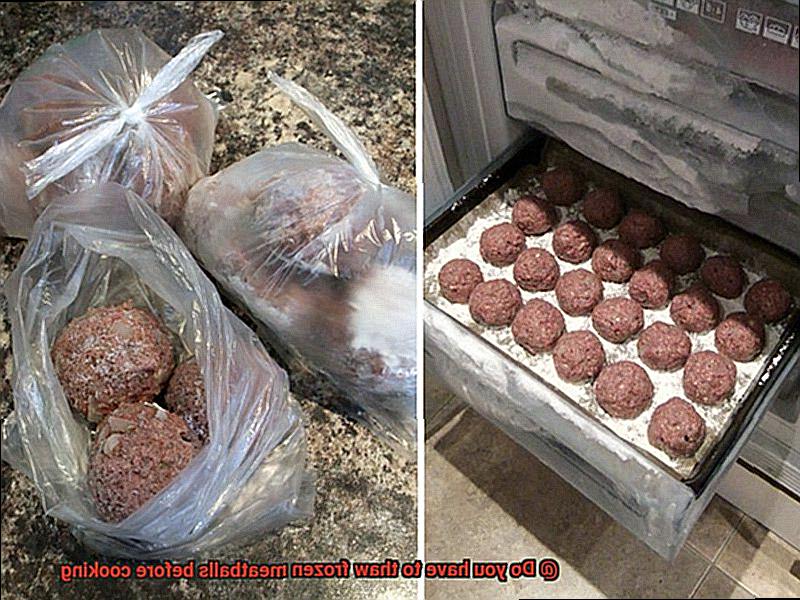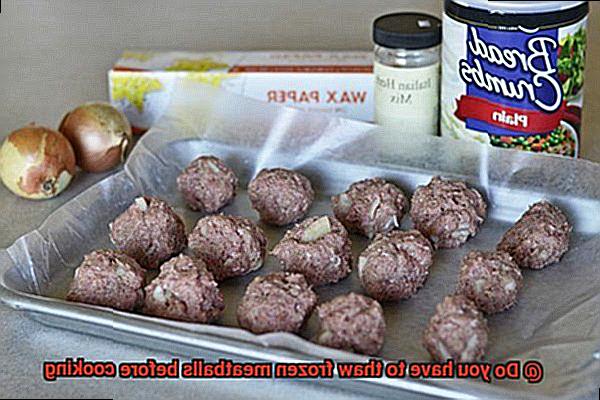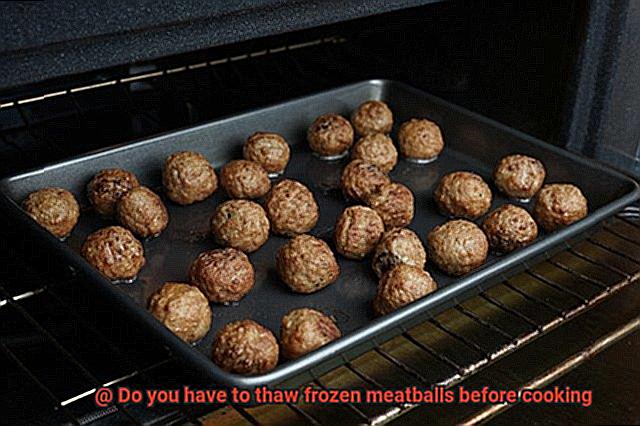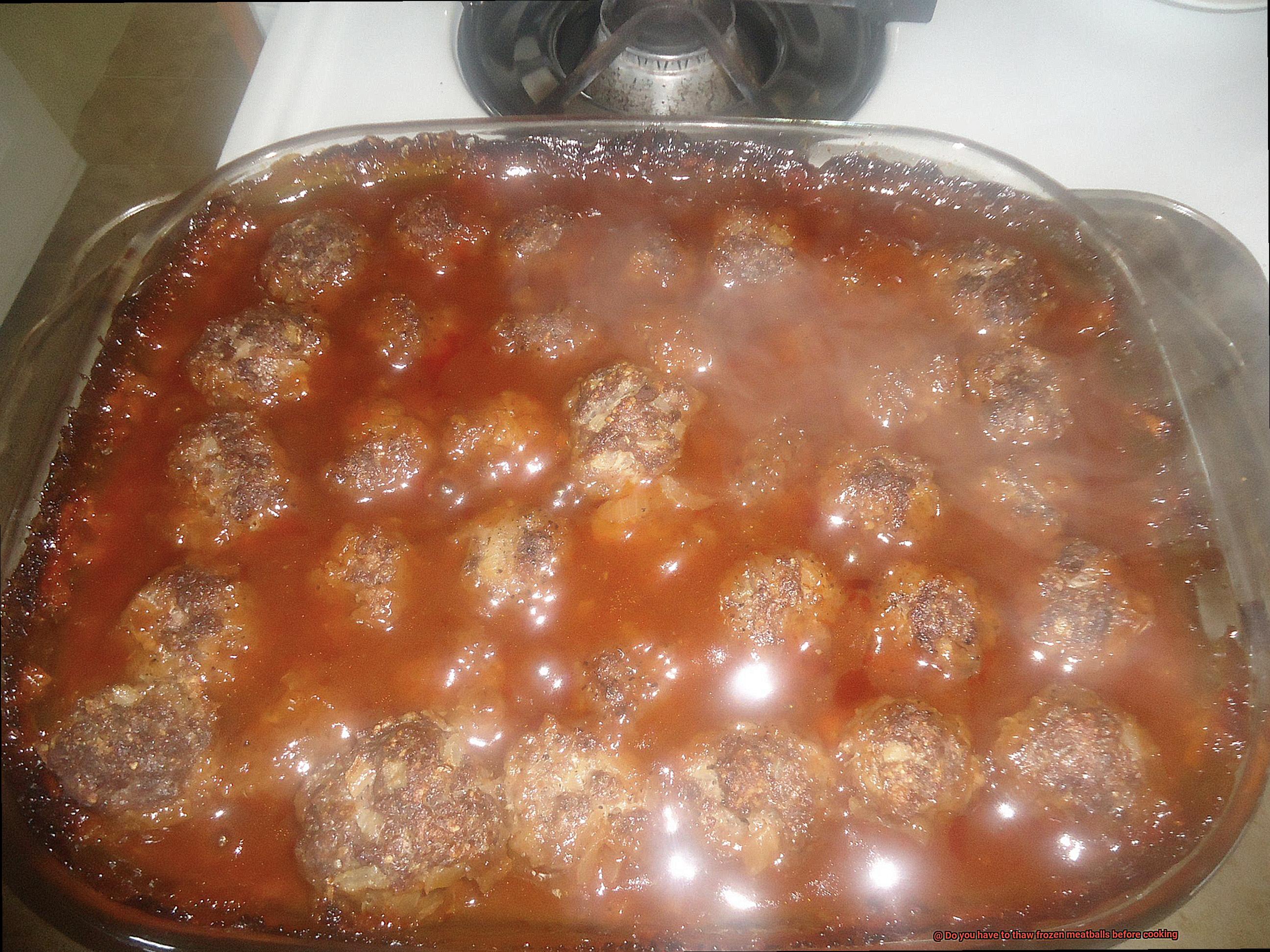- Picture this: you’ve had a long day and the only thing on your mind is getting home to whip up a comforting meal for your family. But as you reach for your frozen meatballs, you realize that they’re still rock-solid. Panic sets in – do you wait for them to thaw or chuck them straight into the oven? It’s a common conundrum that many home cooks face, so don’t fret – we’ve got you covered.
- The question remains: Do you have to thaw frozen meatballs before cooking? Well, it’s not as cut-and-dry as you might think. There are certain guidelines to follow to ensure that your meatballs are both safe and scrumptious. In this blog post, we’ll delve deep into the topic and explore all the factors that come into play when deciding whether or not to cook frozen meatballs without thawing first.
We’ll kick things off by examining the science behind cooking frozen foods and how temperature affects cooking time and food safety. Next up, we’ll take a look at some of the best methods for defrosting meatballs if that’s the route you choose. Finally, we’ll dish out some expert tips on how to cook frozen meatballs to perfection.
Whether you’re a newbie in the kitchen or a seasoned pro, this blog post will equip you with all the know-how needed to whip up an incredible meal using your trusty frozen meatballs. So sit back, relax, and let’s dive headfirst into the wonderful world of cooking with frozen foods.
Contents
What is the Question: Do You Have to Thaw Frozen Meatballs Before Cooking?
There are a few things to keep in mind to ensure that they’re cooked safely and evenly.
Firstly, the cooking method you plan to use is crucial. If you’re grilling or baking your meatballs, it’s generally recommended that you thaw them first. This will help them cook evenly throughout and reduce cooking time. If you’re simmering them in a sauce or using a slow cooker, on the other hand, you may be able to skip the thawing process altogether.
It’s also important to consider the type of meat in your meatballs. Raw ground beef or pork meatballs are generally safer when thawed before cooking as cooking frozen raw meatballs can increase the risk of bacteria growth and foodborne illness. However, if you’re using pre-cooked frozen meatballs from the grocery store, they’re likely safe to cook from frozen as they’ve already been fully cooked and then frozen for convenience.
If you choose to cook your frozen meatballs without thawing them first, there are a few extra precautions you should take. Since they’re frozen, they’ll take longer to cook than fresh meatballs. Therefore, you may need to adjust your cooking time accordingly and use a meat thermometer to ensure that they reach a safe internal temperature (165°F for beef and pork, 160°F for ground turkey or chicken). Additionally, if you plan on grilling your frozen meatballs, preheating them in the oven or on the stovetop first can help them cook more evenly and prevent them from falling apart on the grill.
Factors to Consider When Deciding Whether or Not to Thaw Meatballs
Don’t fret, cooking frozen meatballs is definitely doable. However, before you start cooking, there are several factors to consider when deciding whether or not to thaw them first.
One of the main factors to keep in mind is the cooking method you plan to use. If you’re grilling the meatballs, it’s best to thaw them first. This ensures they cook evenly and thoroughly without falling apart on the grill. However, if you’re baking or simmering the meatballs in sauce, cooking them from frozen is just as fine.
Another important factor is the size of the meatballs. Smaller meatballs can be cooked from frozen without posing any food safety risks. However, larger meatballs may take longer to cook through and could potentially be undercooked in the center if cooked from frozen. In such cases, it’s best to thaw them first.
When it comes to cooking frozen meatballs, it’s crucial to ensure they reach a safe internal temperature of 160°F. This may take longer than cooking thawed meatballs and increase the risk of foodborne illness. Therefore, thawing the meatballs before cooking can reduce this risk while ensuring they reach their safe internal temperature.
Lastly, consider the texture and flavor of your meatballs. Thawing them before cooking can help retain their moisture and prevent them from becoming dry or tough. It can also help infuse more flavor into the meatballs as they absorb any marinades or seasonings more effectively.
Pros and Cons of Thawing Frozen Meatballs
Thawing frozen meatballs before cooking provides several benefits. Firstly, it ensures even and thorough cooking, resulting in a juicy and flavorful end product. Frozen meatballs tend to have uneven cooking, with the outer layer getting overcooked while the inside remains undercooked. Thawing them first allows the meatballs to cook uniformly throughout.
Moreover, thawing can save you time in the kitchen. You can thaw the meatballs in advance, allowing you to start cooking them right away when you’re ready to eat. This is especially helpful if you’re preparing a large meal and need to get everything cooked and on the table quickly.

However, there are some downsides to thawing frozen meatballs before cooking. One potential disadvantage is that it can increase bacterial growth. When meat is frozen, any bacteria present are put on hold. But as the meat thaws, bacteria can start to multiply again, increasing the risk of foodborne illness if the meat isn’t cooked properly.
Another drawback is that thawing frozen meatballs can lead to a loss of flavor and moisture. As the meat thaws, some of its natural juices are released, making it less juicy and flavorful once cooked. If not properly wrapped or stored during the thawing process, it can also become dry or develop freezer burn, which can impact its taste and texture.
So, what’s the verdict? To decide whether or not to thaw your frozen meatballs before cooking depends on various factors such as personal preference, cooking method, and food safety concerns. If you have time and want to ensure even cooking and maximum juiciness and flavor, thawing is the way to go. However, if you’re in a rush or concerned about food safety, cooking your meatballs from frozen is still a viable option. Just be sure to cook them thoroughly and check their internal temperature with a meat thermometer to ensure they are safe to eat.
The Importance of Following Recipe Instructions and Food Safety Guidelines
Cooking is an art, and just like any other art form, it requires patience, precision, and attention to detail. When it comes to cooking frozen meatballs, following recipe instructions and food safety guidelines is crucial. Skipping steps or taking shortcuts may seem like a time-saver, but it can result in undercooked or unsafe food.
Firstly, recipe instructions provide specific guidance on cooking times and temperatures. These are crucial for ensuring that the meatballs are cooked through and safe to eat. Skipping steps like thawing the meatballs before cooking can throw off these cooking times and temperatures, potentially leaving the meatballs undercooked and unsafe to consume. In addition, not following recipe instructions can lead to a meal that is subpar in terms of texture and taste.
Moreover, food safety guidelines must be followed to prevent the risk of foodborne illness. Raw meat, including frozen meatballs, can harbor harmful bacteria like salmonella or E. coli. Thawing the meatballs properly and cooking them to the correct temperature can help kill these bacteria and reduce the risk of illness. By following food safety guidelines, you not only protect yourself from illness but also your loved ones who will be sharing the meal with you.
Here are some essential things you should keep in mind when cooking frozen meatballs:
- Always read the recipe instructions carefully before beginning.
- Thaw frozen meatballs in the refrigerator overnight instead of on the counter at room temperature.
- Use a food thermometer to ensure that your meatballs have reached an internal temperature of 165°F (74°C) before serving.
- Avoid overcrowding the pan when cooking your meatballs as this can cause uneven cooking.
- Follow any additional safety guidelines provided by your recipe or your local health department.

Different Methods for Thawing Frozen Meatballs
Firstly, we have the refrigerator method, which is ideal for those who have some advanced planning and time management skills. This method involves placing the frozen meatballs in a container and leaving them in the fridge for several hours or overnight. Although it is the safest method as it allows the meatballs to thaw gradually and evenly, reducing the risk of foodborne illnesses, it requires patience.
Next up is the cold water method. It’s faster than using the refrigerator and takes only about an hour or two. All you need to do is place your frozen meatballs in a sealed plastic bag and submerge them in cold water. This method requires a bit of planning ahead of time, but it’s a great option if you need your meatballs thawed quickly.
Lastly, we have the microwave method. This is by far the fastest option but also has its risks if not done properly. It involves placing your frozen meatballs on a microwave-safe plate and heating them on low power for a few minutes at a time until they’re fully thawed. However, there’s a risk of partially cooking the meatballs, leading to uneven cooking. Use caution and check frequently to avoid any mishaps.
To summarize, there are different methods for thawing frozen meatballs that cater to your needs and time constraints. The refrigerator method is safe but requires advanced planning; the cold water method is faster but still requires some planning ahead of time; and the microwave method is the quickest but requires careful attention.
Tips for Cooking Frozen Meatballs Without Thawing Them First
If you’re looking for a quick and easy dinner option, frozen meatballs can be a lifesaver. However, cooking them without thawing them first can be challenging. Here are some tips to make sure your frozen meatballs are cooked properly without thawing them first.
Preheat Your Cooking Surface

No matter what cooking method you choose, preheating your cooking surface is crucial to ensure that the meatballs cook evenly and don’t stick. When cooking frozen meatballs in the oven, it’s essential to preheat the oven to 350°F before adding the meatballs. If you’re using a skillet or grill, make sure to preheat it to medium heat before adding the meatballs.
Bake Instead of Frying
While frying is a popular cooking method for meatballs, it’s not recommended for frozen ones. The outside can burn while the inside remains undercooked. Baking is a better option for frozen meatballs. To bake frozen meatballs, place them on a baking sheet lined with parchment paper and bake at 350°F for 20-25 minutes, turning them over halfway through cooking.
Use a Slow Cooker
Slow cooking is another great option for cooking frozen meatballs. This method is perfect for busy home cooks who want to set it and forget it. Simply place the frozen meatballs in a slow cooker with your desired sauce and cook on high for 2-3 hours or on low for 4-5 hours.
Don’t Overcrowd the Pan
When cooking frozen meatballs on the stovetop or grill, it’s essential not to overcrowd the pan. Leaving enough space between each meatball allows for even cooking. Overcrowding can cause the meatballs to steam instead of brown, resulting in a less appetizing texture.
Use a Thermometer
The only way to ensure that your frozen meatballs are cooked through is by using a meat thermometer. Insert the thermometer into the thickest part of the meatball and cook until it reaches an internal temperature of 165°F. This is especially important when cooking frozen meatballs, as they may take longer to cook than fresh ones.
Add Some Liquid
Adding a liquid to the pan or baking dish can help prevent the frozen meatballs from drying out. You can use broth, water, or sauce to infuse flavor into the meatballs and create a delicious sauce for serving. Be sure not to add too much liquid, as this can cause the meatballs to become soggy.
Alternatives to Cooking Frozen Meatballs
As an expert on the topic of frozen meatballs, I have researched some alternatives to cooking them that will save you time and still yield scrumptious results.
The first alternative is the slow cooker method. This technique is perfect for those who want their meatballs infused with the flavors of their favorite sauce. Simply toss the frozen meatballs into your slow cooker, pour your preferred sauce over them, and let them cook on low heat for 4-6 hours or high heat for 2-3 hours. The outcome? Succulent and flavorful meatballs that will leave you wanting more.
If you’re short on time, baking your frozen meatballs in the oven is a quick and effortless alternative. Preheat your oven to 350°F, place your frozen meatballs on a baking sheet lined with parchment paper, and bake for 20-25 minutes until heated through. You can even add some oil or butter to the pan for an added burst of flavor.

Lastly, if you crave that satisfying crunch on the outside of your meatballs, look no further than the stovetop method. Heat up a pan over medium-high heat with a tablespoon of oil, add your frozen meatballs, and cook them for 6-8 minutes, stirring occasionally until heated through and slightly caramelized. The result? Deliciously crispy meatballs that will make your taste buds dance with joy.

4a2hQpj6Dxc” >
Conclusion
In conclusion, frozen meatballs offer a convenient solution for busy home cooks looking to whip up a quick and satisfying meal. However, the question of whether or not to thaw them before cooking can be perplexing. The answer ultimately depends on various factors such as personal preference, cooking method, and food safety concerns.
If you’re seeking maximum juiciness and flavor with even and thorough cooking, it’s best to thaw your frozen meatballs before cooking them. This ensures that all parts of the meatball cook evenly, reducing the risk of foodborne illness. But if you’re pressed for time or concerned about food safety, there are still viable options for cooking frozen meatballs without thawing them first.
When it comes to thawing your frozen meatballs, there are different methods that cater to your needs and time constraints. Whether you choose the refrigerator method for overnight thawing or opt for the quicker cold water or microwave methods, always follow recipe instructions and food safety guidelines for safe consumption.
Expert tips for cooking frozen meatballs without thawing them first include preheating your cooking surface, baking instead of frying, using a slow cooker, avoiding overcrowding the pan, using a thermometer to check internal temperature and adding some liquid to prevent drying out.
No matter which method you choose to cook your frozen meatballs with or without thawing them first always prioritize food safety by following proper storage and handling procedures.






